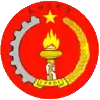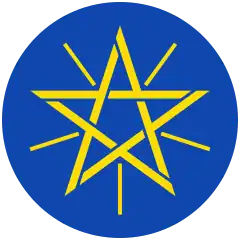Ethiopian People's Revolutionary Democratic Front
The Ethiopian People's Revolutionary Democratic Front (EPRDF; Amharic: የኢትዮጵያ ሕዝቦች አብዮታዊ ዲሞክራሲያዊ ግንባር, romanized: Ye’Ītiyop’iya Ḥizibochi Ābiyotawī Dīmokirasīyawī Ginibari) was an ethnic federalist[4] political coalition in Ethiopia that existed from 1988 to 2019. It consisted of four political parties: Tigray People's Liberation Front (TPLF), Amhara Democratic Party (ADP), Oromo Democratic Party (ODP) and Southern Ethiopian People's Democratic Movement (SEPDM).[4] After leading the overthrow of the People's Democratic Republic of Ethiopia, it dominated Ethiopian politics from 1991 to 2019. In November 2019, the EPRDF was dissolved, and Prime Minister and EPDRF chairman Abiy Ahmed merged three of the constituent parties (not including the TPLF) into his new Prosperity Party,[5] which was officially founded on 1 December 2019.
Ethiopian People's Revolutionary Democratic Front | |
|---|---|
 | |
| Chairman | Abiy Ahmed |
| Deputy Chairman | Demeke Mekonnen |
| Founded | 8 May 1988 |
| Dissolved | 1 December 2019 |
| Succeeded by | Prosperity Party |
| Headquarters | Addis Ababa |
| Newspaper | New Vision |
| Youth wing | EPRDF Youth League |
| Women's wing | EPRDF Women's League |
| Membership (2011) | 6,000,000 |
| Ideology | After 1991: Revolutionary democracy Ethnic federalism Poly-Ethnic nationalism[1] Until 1991: Marxism–Leninism Hoxhaism[2][3] |
| Political position | After 1991: Centre-left to left-wing Until 1991: Far-left |
| Colours | Red |
| Website | |
| eprdf | |
| Ethiopian People's Revolutionary Democratic Front | |
|---|---|
 | |
| Leaders | |
| Dates of operation | 1988–2019 |
| Headquarters | Addis Ababa, Ethiopia |
| Ideology | Ethnic federalism |
| Status | Dissolved. Its ideology still permeates Ethiopian politics. |
| Allies | |
| Opponents | |
| Battles and wars | Oromo conflict, Ethiopian Civil War, Eritrean–Ethiopian War |
History
During the Ethiopian Civil War, the EPRDF was a rebel group battling the Derg, a military regime led by Mengistu Haile Mariam that was effectively in power from 1974 until it was replaced by the People's Democratic Republic of Ethiopia in 1987. During this period, the Derg was responsible for the deaths of tens of thousands of opponents without trial in the Qey Shibir and the 1983–1985 famine in Ethiopia resulting in 400,000 deaths.[6]
The EPRDF was formed by the union of the TPLF and the Ethiopian People's Democratic Movement (EPDM) in early-1989. They were later joined by the OPDO (the Oromo members of the TPLF, EPLF, and EPDM) and the Ethiopian Democratic Officers' Revolutionary Movement (a small body of Derg officers captured by TPLF, most notably at Shire in February 1989, which was later disbanded after the establishment of the Transitional Government of Ethiopia).[4]
Following the collapse of the People's Democratic Republic of Ethiopia in the early 1990s, the EPRDF gained support from the United States. Michael Johns, an Africa expert with The Heritage Foundation, wrote in 1991 that "there are some modestly encouraging signs that the front intends to abandon Mengistu's autocratic practices".[7]
Leadership
- Meles Legesse Zenawi Asres (8 May 1988 – 20 August 2012)
- Hailemariam Desalegn Boshe (16 September 2012 – 27 March 2018)
- Abiy Ahmed Ali (27 March 2018 – 1 December 2019)
Organization
The EPRDF was an alliance of four political parties:
- Oromo Democratic Party (ODP), which is based in the Oromia Region (formerly known as OPDO)
- Amhara Democratic Party (ADP) based in the Amhara Region (formerly known as ANDM)
- Southern Ethiopian People's Democratic Movement (SEPDM) based in the Southern Nations, Nationalities, and Peoples' Region
- Tigray People's Liberation Front (TPLF) based in the Tigray Region
The EPRDF was led by a Council as well as an executive committee, whose members were selected every three years by a congress of the party. The four member parties had the same organizational structure. Government and party structures were closely intertwined.[8]
The other five regions of Ethiopia were governed by parties which were either created or heavily influenced by the EPRDF.[9] One of the earliest was the Afar People's Democratic Organization in the Afar Region, which subsequently merged with other Afar political groups to create the Afar National Democratic Party (ANDP).[10] These were the five regional parties:[11]
- Afar National Democratic Party (ANDP) in Afar Region
- Argoba People's Democratic Organization (APDO) for the Argobba people
- Hareri National League (HNL) in Harari Region
- Gambela People's Democratic Movement (GPDM) in Gambela Region
- Ethiopian Somali People's Democratic Party (ESPDP) in Somali Region
- Benishangul-Gumuz People's Democratic Unity Front (BGPDUF) in Benishangul-Gumuz Region
Ideology
Revolutionary democracy
Revolutionary democracy replaced Marxism–Leninism as the EPRDF's official ideology in the early 1990s, not because the front had lost their belief in Marxism, but rather because of the international situation (the Soviet Union was dissolved in 1991).[12] The main message of Revolutionary Democracy, similar to that found in Marxist–Leninist thought, is that a vanguard party should rule because it represents the people and has "supposedly superior knowledge of the nature of social development conferred on them by the EPRDF ideology."[13] Similar to Marxism–Leninism, the EPRDF prefers to categorize society into classes such as the peasantry, the bourgeoisie, the proletariat and the comprador bourgeoisie and considers its main adversary to be imperialism, that is free market capitalist states.[13]
The peasantry are considered the main class in Ethiopia, since they form a majority of the population, and they are considered the pillar of Revolutionary Democracy.[14] Upon seizing power, the front was suspicious of the petite bourgeoisie class, believing that they were naturally inclined to oppose the front's policies.[15] Despite this, the front believed it could win over the petite bourgeoisie through economic incentives and successful policy.[15] Importantly, if members of the petite bourgeoisie class oppose the EPRDF, the front will "empty their 'belly and pocket'".[16] The urban proletariat are in contrast naturally inclined towards the EPRDF, and the EPRDF seeks to recruit members of these class so as to strengthen the front's organizational links with the trade unions.[16] The EPRDF asserts that the "local investor", that is, the capitalist, will naturally be hostile towards the front and its policies, and the front should therefore try to persuade this class to become neutral.[16] Religious organizations are deemed reactionary by the EPRDF.[17]
Some people state that the EPRDF has not espoused a well-defined unified ideology or political philosophy. Its members held a variety of positions that could be broadly defined as being to the left of the opposition parties.[4] The EPRDF traditionally identified itself with a number of general goals, namely rapid export-based economic growth; close cooperation with the United States in foreign and defense policies; close cooperation with China on economic and trade policies: and several newer issues, such as administrative reform. Administrative reform encompassed several themes, namely simplification and streamlining of government bureaucracy; privatization of state-owned enterprises; and adoption of measures, including tax reform, in preparation for the expected strain on the economy posed by a rapidly growing population.[18] Other priorities in the early 1990s included the promotion of a more active and positive role for Ethiopia following the collapse of the People's Democratic Republic of Ethiopia, the internationalization of Ethiopia's economy by the liberalization and promotion of domestic demand (expected to lead to the industrialization) and the promotion of education.[18] A business-inspired commitment to free enterprise was tempered by the insistence of protectionism and tariffs.
Relation to liberalism
The EPRDF opposes liberal democracy, and liberalism in general.[19] Despite this, Revolutionary Democracy can be considered a mixture of communist and liberal thought.[19] The front views liberal democracy and free market capitalism as decadent, and has a "romantic attachment" to the beliefs of Vladimir Lenin, who condemned liberal democracy as the dictatorship of the bourgeoisie (literally the dictatorship of the upper class) while supporting Lenin's assertion of the need for a vanguard party which practices democratic centralism.[19] It considers liberal democracy to be "ill-fit and unsustainable", but ironically much of the front's economic policies are based on the tacit acknowledgement of the need of some liberalism in the economic field.[19]
Relation to communism
With the majority of EPRDF's top leaders being former members of the Marxist–Leninist League of Tigray, a Hoxhaist organization led by among others Meles Zenawi, Marxist ideology still plays a prominent role in party discourse, with some even claiming that the front is hiding their ideology.[20] Theodore M. Vestal claims that the front based its ideology on Marxist–Leninist revisionism, believing it explains the regime's authoritarian nature.[21] Of the communists traits in Revolutionary Democracy, most of them have been borrowed from Mao Zedong Thought, an ideology conceived by Chinese leader Mao Zedong.[19]
Election results
| Election | Leader | No. of candidates | No. of seats won | No. of Constituency votes | % of Constituency vote | Government/Opposition |
|---|---|---|---|---|---|---|
| 1995 | Meles Zenawi | 1,881 | 471 / 500 |
16,429,727 | 82.9% | Government |
| 2000 | Meles Zenawi | 472 / 527 |
Government | |||
| 2005 | Meles Zenawi | 327 / 527 |
12,237,655 | 59.8% | Government | |
| 2010 | Meles Zenawi | 1,349 | 499 / 547 |
Government | ||
| 2015 | Hailemariam Desalign | 1,851 | 500 / 547 |
26,403,177 | Government |
Notes
- Alem Habtu. "Ethnic Federalism in Ethiopia: Background, Present Conditions and Future Prospects". S2CID 11477280.
{{cite journal}}: Cite journal requires|journal=(help) - "Warum Ahmed ein guter Preisträger ist – trotz seiner Fehler". ZDF.
- "Kommentar: Äthiopiens Reformregierung und die Kräfte des ethnischen Nationalismus". Deutsche Welle.
- Vaughan, Sarah (2003). "Ethnicity and Power in Ethiopia" (PDF). Archived 13 August 2011 at the Wayback Machine University of Edinburgh: Ph.D. Thesis. p. 168.
- Exclusive: Third day EPRDF EC discussing "Prosperity Party" Regulation. Find the draft copy obtained by AS
- de Waal, Alex (1997). Famine Crimes: Politics & the Disaster Relief Industry in Africa. Oxford: James Currey. ISBN 0-85255-810-4.
- Johns, Michael (August 1991). "Does Democracy Have a Chance?" Archived 23 August 2013 at the Wayback Machine. The World and I, in: The Congressional Record (6 May 1992).
- Parteien in Äthiopien: Zwischen ethnischer Orientierung und Programmausrichtung (PDF). Friedrich Ebert Foundation.
- Chanie, Paulos (2007). "Clientelism and Ethiopia's post-1991 decentralisation". The Journal of Modern African Studies. 45 (3): 355–384. doi:10.1017/S0022278X07002662. S2CID 154750210.
- Yasin, Yasin Mohammed (2008). "Political history of the Afar in Ethiopia and Eritrea" Archived 1 March 2012 at the Wayback Machine (PDF). African Affairs, in: Africa Spectrum. 42 (1): p. 39–65.
- Aalen, Lovise (2006). "Ethnic Federalism and Self-Determination for Nationalities in a Semi-Authoritarian State: the Case of Ethiopia". International Journal on Minority and Group Rights. 13 (2): 243–261. doi:10.1163/157181106777909849.
- Vestal 1999, pp. 63–64.
- Vestal 1999, p. 64.
- Vestal 1999, p. 73.
- Vestal 1999, p. 74.
- Vestal 1999, p. 75.
- Vestal 1999, p. 77.
- Ethiopia's Great Run: The Growth Acceleration and How to Pace It (PDF). World Bank. 2015.
- Melakedingel, Nolawi (10 May 2013). "The Oddities of 'Revolutionary Democracy'". Addis Standard. Retrieved 1 July 2014.
- Vestal 1999, pp. 79–80 & 93.
- Vestal 1999, p. 116.
References
- Vestal, Theodore (1999). Ethiopia: A Post-Cold War African State (1st ed.). Praeger Publishers. ISBN 0275966100.